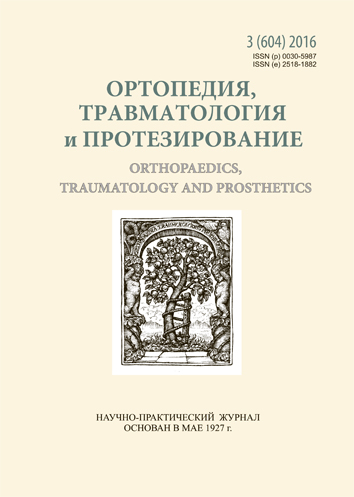Modern approaches to the treatment of tuberculosis spondylitis
DOI:
https://doi.org/10.15674/0030-59872016385-89Keywords:
tuberculous spondylitis, treatment outcomes, diagnosticsAbstract
In today’s epidemiological situation incidence of osteoarticular tuberculosis takes the first place in the structure and morbidity of extrapulmonary tuberculosis in our country, and tuberculosis of the spine has the first place among the bones and joints affection.
Purpose: to attract the attention of practitioners to the problem of tuberculosis spondylitis treatment (TS) and improving its efficiency.
Methods: The survey data reports and medical records of 175 patients diagnosed for the first time TC. The patients were divided into two groups: I — 93 (53.1 %) subjects underwent surgery on the affected vertebrae by specific destructive process, II — 82 (46.9 %) patients after the conservative treatment. Patients in group I by neurological disorders degree as follows: Type A — 8, B — 12, C — 16, D — 40, E — 17. Patients with uncomplicated disease, as well as with the indication to surgical treatment, but with significant risk of decompensation due to comorbidities continued conservative treatment. In group II patients with severe neurological were less: Type A — 0, B — 0, C — 3, D — 7, E — 72. Chemotherapy was conducted according to internationally accepted protocols and standards Tuberculosis (Order No 620, 2014 , Ministry of Health of Ukraine).
Results: long-term results of TS treatment (2 to 10 years) were studied in 85 (91.4 %) patients in group I and in 76 (92.7 %) — II. Clinical, radiological, neurological surveys, as well as in the case shown, the computer tomography revealed no recurrence of the disease. Excellent results were obtained in 46 (54.2 %) patients in group I and in 65 (85,6 %) — II, good — in 21 (24.7 %) and 9 (11.8 %), respectively, satisfactory — 14 (16.4 %) and 2 (2.6 %). Unsatisfactory results were observed in 4 (4.7 %) patients in group I.
Conclusions: The analysis of the long-term results in the treatment of patients showed that the use of combination therapy, and surgical treatment of TS allows to achieve high efficiency of treatment.References
- Vasilyev АV. Extrapulmonary tuberculosis: Guidelines for doctors. Saint Petersburg, 2000. 327 p.
- Golka GG. Ways for improvement of treatment efficiency in patients with tuberculous spondylitis. Orthopedics, Traumatology and Prosthetics. 2004;2:14–9.
- Perelman MI, Levashev YuN. Diagnosis and treatment of extrapulmonary tuberculosis: practical guidelines. Moskow: Medicine and Life, 2002. 600 p.
- Kornev PG. Surgery in osteo-articular tuberculosis: in 3 vol. Leningrag: Medicine, 1971. 810 p.
- Levashev YuN, Garbuz АЕ. Osteo-articular tuberculosis. Мoskow: Medicine and Life. 2003. 294 p.
- Nizova NМ, Golubchikov МV. Tuberculosis in Ukraine: analytical and statistical reference book for 2004-2014. Kyiv, 2015. 116 p.
- Ulrikh EV, Mushkin YuМ. Vertebrology in terms, figures and pictures. Saint Petersburg: Elby-St.Pb, 2002. 186 p.
- Global tuberculosis control 2011 (Report on global tuberculosis control 2011): World Health Organization [Onlinesource]. Access mode: http://www.who.int/tb/publications/global_report/2011/.
Downloads
How to Cite
Issue
Section
License
Copyright (c) 2016 Grigoriy Golka, Volodymyr Vesnin

This work is licensed under a Creative Commons Attribution 4.0 International License.
The authors retain the right of authorship of their manuscript and pass the journal the right of the first publication of this article, which automatically become available from the date of publication under the terms of Creative Commons Attribution License, which allows others to freely distribute the published manuscript with mandatory linking to authors of the original research and the first publication of this one in this journal.
Authors have the right to enter into a separate supplemental agreement on the additional non-exclusive distribution of manuscript in the form in which it was published by the journal (i.e. to put work in electronic storage of an institution or publish as a part of the book) while maintaining the reference to the first publication of the manuscript in this journal.
The editorial policy of the journal allows authors and encourages manuscript accommodation online (i.e. in storage of an institution or on the personal websites) as before submission of the manuscript to the editorial office, and during its editorial processing because it contributes to productive scientific discussion and positively affects the efficiency and dynamics of the published manuscript citation (see The Effect of Open Access).














